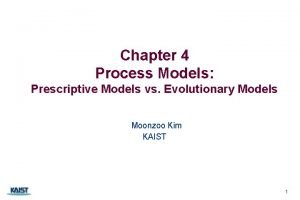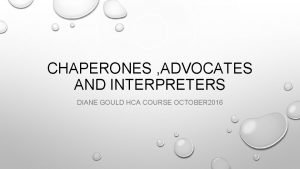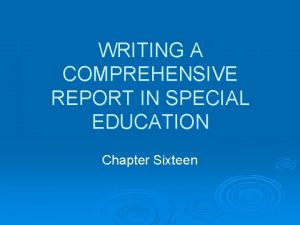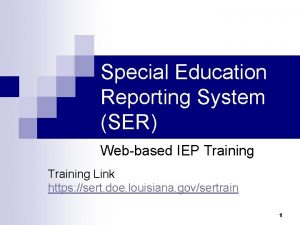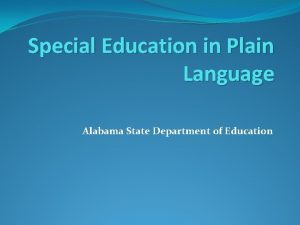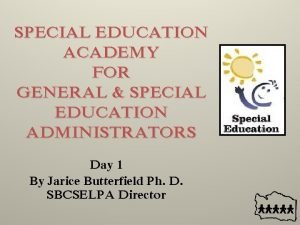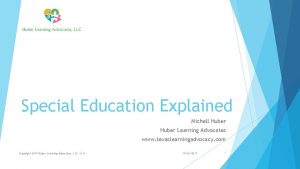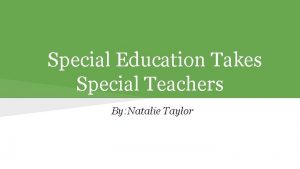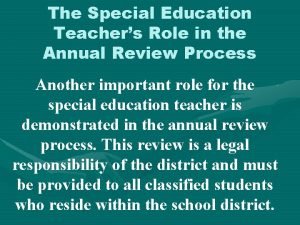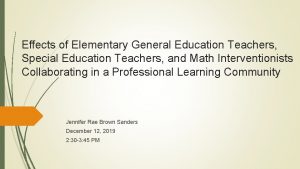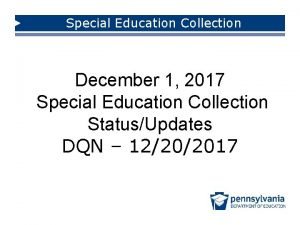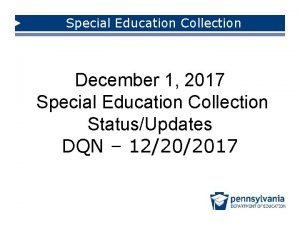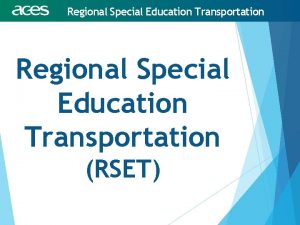Special Education Teachers Role As Advocates Role As
















- Slides: 16

Special Education Teachers: Role As Advocates

Role As Advocates �Ensure that the best interests of the student is represented �Be aware of State/Federal Laws pertaining to Special Needs �Ability to research special cases if need arises �Inform parents/caretakers about their rights

Role As Advocates �Suggest appropriate services/programs for student’s individual needs �Provide classroom observation reports �Preparents for IEP/504 Meeting �Review special education documents �Draft letters/responses/complaints/ requests to School/ District Officials �Empower and educate families (successbydesigneducation. com)

Importance of Detecting Exceptionalities �To minimize children’s chances of being behind academically �Neural circuits flexible during first three years of life �Positively alters the child’s developmental trajectory �Less costly �Earlier the intervention, better the outcome. (learningliftoff. com)

Identifying a gifted student with disabilities “GLD” (gifted with a learning disability), these children “twice exceptional” (2 e), and “double labelled”. Their disabilities can include ADD/ADHD, dyslexia, processing disorders, Aspergers’ and physical and emotional disorders. These children may be in gifted programs but it is more likely that they would be in a specialist remedial program with their intellectual giftedness ignored.

5 Most Common Learning Disabilities �Dyslexia �ADHD �Dyscalculia �Dysgraphia �Processing Deficits

4 Laws/Policies Related to Children with Exceptionalities �The Rehabilitation Act of 1973 �Education for all Handicapped Children Act, 1975. �Individuals with Disabilities Education Act, 1990. �Elementary and Secondary Education Act or No Child Left Behind, 2001.

The Rehabilitation Act of 1973 The Rehabilitation Act prohibits discrimination on the basis of disability in programs conducted by Federal agencies, in programs receiving Federal financial assistance. (ada. gov)

Education for all Handicapped Children Act, 1975 In 1975, Congress passed the Education for All Handicapped Children Act with the goal of remedying the serious educational inequalities represented by these numbers. The central principle of the act mandated that all states receiving federal education funding must create a “policy that assures all handicapped children the right to a free appropriate public education” (Moody, 2012)

Individuals with Disabilities Education Act, 1990 The Individuals with Disabilities Education Act (IDEA) requires public schools to make available to all eligible children with disabilities a free appropriate public education in the least restrictive environment appropriate to their individual needs. (ada. gov)

Elementary and Secondary Education Act or No Child Left Behind, 2001. The major focus of No Child Left Behind is to close student achievement gaps by providing all children with a fair, equal, and significant opportunity to obtain a highquality education. (k 12. wa. us)

Three examples of ways in which advocating for students and families optimizes learning opportunities for young children �Can coach parents so that they can appear before authorities and secure the rights of their children �Ensure that children with disabilities are educated in the same classroom as the children who do not have disabilities �Ensure that Free and Appropriate Public Education (FAPE) is provided for all children with disability

3 -5 talking points �As advocates/teachers of special education we can assist and help parents to get important services for their children with disabilities � Ensure that you maintain a high level of professional competence & integrity while utilising your professional judgement which will benefit students with exceptionalities and their family members.

3 -5 talking points �Always ensure that you develop cordial relationships with families of students with exceptionalities and involve them in the educational decision making �Do protect and support the physical and psychological �Never indulge in any activity that would harm the student with exceptionalities

References What does a Special Education Advocate Do? : Success By Design Education. (n. d. ). Retrieved October 20, 2019, from http: //www. successbydesigneducation. com/s pecial-education-advocate-vs-attorney/. Why Early Intervention in Education Is Important for Children with Developmental Disabilities. (2017, November 22). Retrieved October 20, 2019, from https: //www. learningliftoff. com/why-earlyintervention-in-education-is-important-forchildren-with-developmental-disabilities/. National Academy Press. (2001). Educating children with autism. Washington, DC.

References Ethical Principles and Professional Practice Standards for Special Educators. (n. d. ). Retrieved October 20, 2019, from https: //www. cec. sped. org/Standards/Ethical. Principles-and-Practice-Standards. A Guide to Disability Rights Laws. (2009, July). Retrieved October 20, 2019, from https: //www. ada. gov/cguide. htm. Moody, A. (2012, May 3). The Education for All Handicapped Children Act: A Faltering Step Towards Integration. Retrieved October 20, 2019, from https: //commons. trincoll. edu/edreform/2012/05/theeducation-for-all-handicapped-children-act-a-falteringstep-towards-integration/. No Child Left Behind Act of 2001. (n. d. ). Retrieved October 20, 2019, from https: //www. k 12. wa. us/policyfunding/policies/elementary-and-secondary-educationact-esea/no-child-left-behind-act-2001.
 National association of special education teachers
National association of special education teachers Role of special education
Role of special education Kim kroll
Kim kroll Survival skills for advocates
Survival skills for advocates Khurana & khurana advocates and ip attorneys (delhi branch)
Khurana & khurana advocates and ip attorneys (delhi branch) Khurana & khurana advocates and ip attorneys
Khurana & khurana advocates and ip attorneys Early ob advocates
Early ob advocates Difference between prescriptive and evolutionary model
Difference between prescriptive and evolutionary model Diane gould advocates
Diane gould advocates Housing land advocates
Housing land advocates Principles of direct method
Principles of direct method Full form of sjpu
Full form of sjpu Comprehensive written report
Comprehensive written report Louisiana special education reporting system
Louisiana special education reporting system Special education in plain language
Special education in plain language Rowley standard
Rowley standard 504 plan oklahoma
504 plan oklahoma







